The Association of Old Crows (AOC) held the organization’s fifty-fourth convention and symposium in Washington, D.C. the week of November 27, 2017. Founded in 1964, AOC is an international professional organization focused on electronic warfare (EW), tactical information operations and related topics. The symposium attracted 1,633 attendees, almost a 30 percent increase from 2016, and 107 exhibitors, a 10 percent increase from 2016. The attendees came from 25 countries.
For those not active in the organization, the genesis of the name “Old Crows” came from the development of EW during World War II, particularly important during the Battle of Britain and the allied bombing raids over Europe. The allied radar countermeasure operators used the code name “ravens,” which was later changed to “crows.”
Innovation and Change
The theme of this year’s AOC gathering was innovation and change in electromagnetic warfare. Addressing this theme during the three-day conference, the individual sessions were organized into the following tracks:
- evolving and applying innovation in the military,
- international requirements and innovation trends,
- change and innovation in the EW industry,
- innovations in modular, multi-mission, EW/SIGINT/COMMS open systems architectures,
- innovations in software-defined radios (SDR) and transceivers,
- innovations in artificial intelligence and machine learning, and
- innovations in jammer technology.
During the opening session, General Stephen Wilson, Vice Chief of Staff of the U.S. Air Force, spoke about Air Force plans to conduct a comprehensive study of EW requirements through an enterprise capability collaboration team (ECCT). He said the team’s charter and leadership are being finalized, and the 15-month study will kick off by the end of the year. One question to be resolved is whether the team will address cyber threats under the EW umbrella.
In the closing presentation to the conference, General Robin Rand, who heads the Air Force Global Strike Command, said that the military’s response to the development of ballistic missile and nuclear weapons technology by North Korea is behind where it should be. While the U.S. has various programs underway to address the threat, he was quoted as saying, “We’ve got to get humping.”
Exhibition Highlights
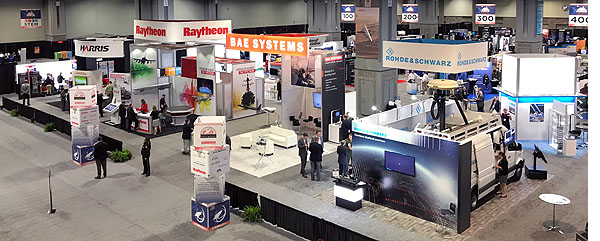
Microwave Journal’s Mike Hallman and Gary Lerude toured the exhibition to get a pulse on how the RF/microwave industry is supporting EW system requirements. The following summarizes a few of the stops they made. You can also view a gallery of photos from their tour.
Analog Devices (ADI) was exhibiting the company’s IC, module and subsystem products and capabilities, highlighting a 10 GSPS, 12-bit, analog-to-digital converter with 7 GHz RF bandwidth. ADI also demonstrated an 8 x 4 element X-Band phased array using a RadioVerse transceiver. The X-Band signal was down- and up-converted to an IF within the 6 GHz bandwidth of the transceiver. Combining Hittite Microwave’s MMIC and module capabilities, which ADI acquired in 2014, with Analog Devices’ own high performance semiconductor portfolio has created a very strong capability for the defense market, one able to transform many system block diagrams.
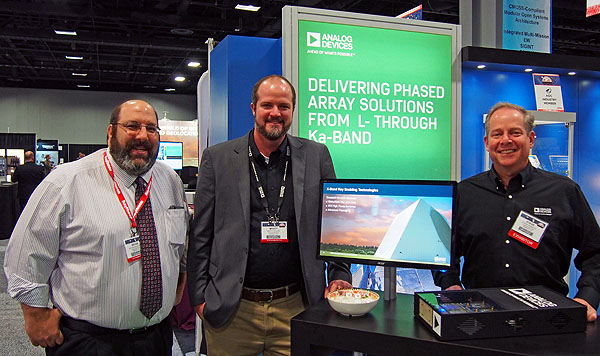
Microwave component supplier Atlanta Micro was speaking with customers about the firm's mission to build high performance products for demanding applications. The product portfolio comprises amplifiers, attenuators, filters, splitters, couplers and switches covering various bands within the DC to 18 GHz range. An interesting product is the AM9011-1 tuner, which is a reference design of 10 Atlanta Micro devices that can be integrated on a printed circuit board to create a tuner with an input frequency range from 2 MHz to 6 GHz with 80 MHz bandwidth and a 60 MHz IF. The tuner has 13 dB noise figure and an input IP3 of +3 dBm.
Cobham Advanced Electronic Solutions, featured by Microwave Journal in a recent Fabs and Labs profile, discussed the range of component to subsystem capabilities offered by the company. Cobham has a long heritage serving the aerospace and defense market, with a pedigree from contributing to many key programs. Particularly impressive is the development of a Ka-Band electronically-steered phased array, being supported by the Air Force Research Laboratory (AFRL).
Empower RF Systems, which began life as a company by supplying high power amplifiers for the jammers used to counter IEDs in Iraq and Afghanistan, has been extending the capabilities of its power amplifiers, integrating more features that control the performance of the amplifier. At AOC, the company was demonstrating pulse shaping, the capability to reproduce an input pulse signal with minimum distortion, using corrections self-generated within the amplifier. Paulo Correa, the company’s chief technical officer, presented a paper on pulse shaping at the track on innovation in jamming technologies.
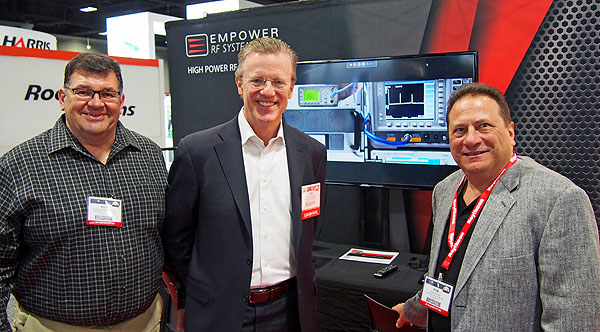
General Microwave, part of the Kratos Microwave Electronics Division, featured the SM60 synthesizer family, which has the capability to modulate the frequency of the synthesizer ±500 MHz about the center frequency with either an analog or digital signal. Settling time to within ±1 MHz of the un-modulated output frequency is 1 µs. The three models in the synthesizer family cover 2 to 18, 6 to 18 and 2 to 20 GHz.
Keysight Technologies' commitment to EW and radar was evident from the demonstration of several system-level measurement and simulation tools: an EW threat simulation system, drone detection and emitter location solution and radar target detection using the SystemVue system modeling software. Keysight's approach to the aerospace and defense market addresses the increasing complexity of system test requirements and provides more capability in the test solutions, particularly enabling users to adapt to changing requirements. Keysight's custom test systems offer multiple configurations for multi-port and multi-channel simulation, enabling users to scale the system as measurement needs change.
Timed for the conference, Mercury Systems announced the SpectrumSeries™ ultra-wideband microwave transceiver for advanced electronic protection and electronic attack applications. The RFM3101 meets OpenVPX™ standards and integrates OpenRFM™ receiver and transmitter building blocks with a local oscillator to achieve low phase noise and high dynamic range. With full spectrum coverage, the transceiver fits in a 3U form factor and is available in both air-cooled and conduction-cooled versions.
National Instruments (NI) was demonstrating high performance RF signal processing capabilities for EW applications. The featured products included an IF transceiver module with a 6 GHz analog bandwidth at 3.2 GSPS data rate or 6.4 GSPS by reducing the bandwidth to 2.6 GHz. The recently announced USRP N310 SDR from Ettus Research, an NI company, was also featured. It covers 10 MHz to 6 GHz with up to four transmit channels, each with 14-bit resolution and 100 MHz instantaneous RF bandwidth, and up to four receive channels, each with 16-bit resolution and 100 MHz instantaneous RF bandwidth. The processing power of the N310 was demonstrated with an LTE link transmitting 4K video.
NuWaves Engineering, based in Middletown, Ohio, was discussing a packaged, 100 W CW power amplifier that covers 1.6 to 2.5 GHz. Biased with a +28 V supply, the LS100A01 is assembled in a 6.5" x 4.5" x 1" housing with SMA connectors. Using GaN transistors, the amplifier achieves up to 48 percent module efficiency, which, with the small form factor, makes the amplifier suited for applications where minimizing size, weight and power is a requirement.
For X-Band EW and radar applications, Pole/Zero was showing a tunable, bandpass filter that frequency hops within 100 ns. Assembled in a small, surface-mount package, the 4-pole filter can be tuned across 8.5 to 11.9 GHz. Pole/Zero can customize the design to meet specific program requirements.
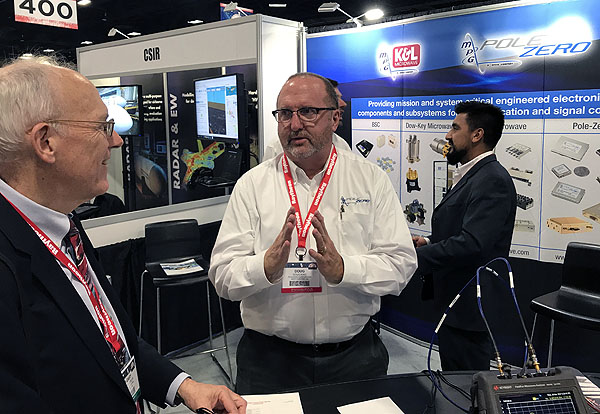
Doug King of Pole/Zero explains the performance of the frequency-hopping X-Band bandpass filter to Microwave Journal's Gary Lerude.
Qorvo was exhibiting their line of Spatium® power amplifiers, which space combine individual GaN power amplifiers to achieve much higher power across broad bandwidths, levels that are competitive with traveling-wave tube amplifiers. The Spatium portfolio covers the classic EW bands from 2 to 6, 2 to 8 and 2 to 18 GHz with output power from 60 to 300 W, depending on the band. Qorvo is expanding the family to cover bands at millimeter wave frequencies, planning additional product releases next year.
RADX Technologies demonstrated three of the company’s software-defined synthetic instruments, which provide users with a suite of instruments: spectrum analyzers, digital storage oscilloscopes, RF receivers and signal generators. The RADX 1410R provides the functionality of a real-time spectrum analyzer with coverage to 26 GHz, 800 MHz instantaneous bandwidth and high probability of intercepting short pulses. RADX’s instruments combine PXIe hardware from NI with patented, real-time synthetic instrumentation technology licensed from BAE Systems.
Rohde & Schwarz had one of the larger booths at AOC, where company staff were discussing the range of radar and EW testing solutions for the collection and analysis of signals, drone protection and security. A new real-time control interface software option enables the creation of dense radar signal environments based on pulse descriptor word (PDW) streaming, where the radar scenario simulator streams the PDWs to a Rohde & Schwarz vector signal generator (VSG). The VSG acts as an agile signal source to generate the RF pulses at high pulse rates, supporting both classical pulsed radar signals and I/Q modulated signals.
The Teledyne Microwave Solutions booth featured a radar warning receiver developed by Teledyne Defence and Space in the U.K. Intended for vessels without situational awareness — called “disadvantaged” vessels in U.K. — the receiver covers 2 to 18 GHz and has two channels with onboard processing and Ethernet outputs. Teledyne has also developed a fast-tuning notch filter to tune out the transmit signal from an X-Band transmitter, to prevent receiver overload. The filter, with a 10 MHz notch bandwidth, can be tuned from 8.5 to 11.5 GHz and is synced with the radar, settling within 250 ns. The filter has more than 50 dB rejection and less than 0.5 dB insertion loss.
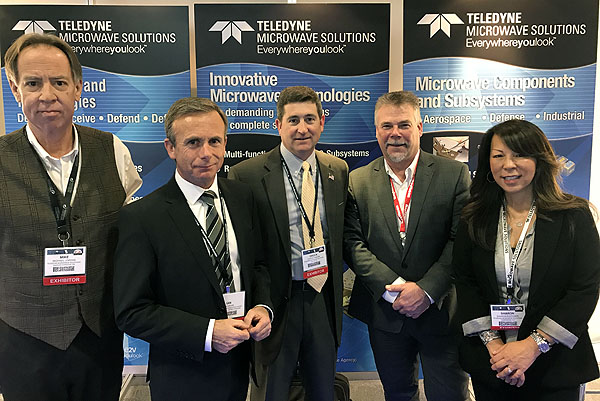
Timed for the AOC show, Wolfspeed announced a GaN on SiC HEMT power amplifier for EW systems. The internally-matched CG2H30070 covers 500 MHz to 3 GHz and delivers a minimum of 70 W CW output power with 12 dB power gain. Drain efficiency is 55 percent. Power combined, two devices achieve greater than 100 W CW from 700 MHz to 3 GHz with 48 percent efficiency at +85ºC. Wolfspeed offers an application circuit for this dual device configuration.
2018 AOC Conference
Next year’s AOC conference will again be held in Washington, from November 27–29.

